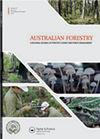研究说明:使用多时相激光雷达数据对辐射松木材体积进行成本效益评估
IF 1.2
4区 农林科学
Q3 FORESTRY
引用次数: 1
摘要
基于多时相机载激光扫描(ALS)和无人机(UAV)的光探测和测距(LiDAR)数据为商业人工林中木材体积变化的建模和估计提供了丰富的时空信息来源。然而,基于ALS的区域性收购的模型更新是非常耗费成本的。本文的目的是研究如何将现有的ALS数据时间序列用于基于无人机激光雷达的木材产量估计更新。我们使用了两个时间序列的ALS数据(2012年和2015年拍摄)和辐射松林分区上的模拟无人机数据。研究区域位于南澳大利亚州米利森特东北10公里处,由一个约21公顷的森林分区组成,其中有库存地块。总共有16个库存地块,每个时间序列的树高和胸径都被作为地面实况数据。开发了一个激光雷达处理框架来推导多时相森林度量。使用k近邻模型,根据这些指标预测木材体积。本文提出了两种方法,使用新获得的无人机激光雷达数据,结合先前同化的全林分ALS数据集,在地块水平上对木材产量估计进行成本效益更新。这两种方法得出的木材体积估计值非常相似。这些发现支持了使用多时相ALS和无人机激光雷达数据进行林业木材产量预测的成本效益更新的可行性。本文章由计算机程序翻译,如有差异,请以英文原文为准。
Research note: cost-efficient estimates of Pinus radiata wood volumes using multitemporal LiDAR data
ABSTRACT Multitemporal airborne laser scanning (ALS) and unmanned aerial vehicles (UAV)-based light detection and ranging (LiDAR) data provide a rich source of spatiotemporal information for modelling and estimating wood volume change in commercial plantation forestry. However, model updates based on area-wide acquisitions of ALS are very cost-intensive. The purpose of this paper is to investigate how existing time series of ALS data can be used for a cost-efficient UAV-LiDAR-based update of timber yield estimates. We used two time series of ALS data (captured in 2012 and 2015) and simulated UAV data over a radiata pine forest compartment. The study area was located 10 km north-east of Millicent, South Australia, and comprised one forest compartment of approximately 21 ha with inventory plots situated inside. In total, 16 inventory plots with measured tree heights and diameter at breast height for each time series were taken as ground-truthing data. A LiDAR-processing framework was developed to derive multitemporal forest metrics. Using k-nearest neighbours modelling, wood volume was predicted based on these metrics. The paper suggests two approaches for the cost-efficient updating of timber-yield estimates using newly acquired UAV-LiDAR data at the plot level in combination with prior assimilated stand-wide ALS datasets. Both approaches produced very similar wood volume estimates. These findings support the feasibility of using multitemporal ALS and UAV-LiDAR data for cost-efficient updates of timber-yield prediction in forestry.
求助全文
通过发布文献求助,成功后即可免费获取论文全文。
去求助
来源期刊

Australian Forestry
FORESTRY-
CiteScore
3.70
自引率
4.80%
发文量
15
审稿时长
>12 weeks
期刊介绍:
Australian Forestry is published by Taylor & Francis for the Institute of Foresters of Australia (IFA) for scientific, technical, and professional communication relating to forestry in the Asia Pacific.
 求助内容:
求助内容: 应助结果提醒方式:
应助结果提醒方式:


